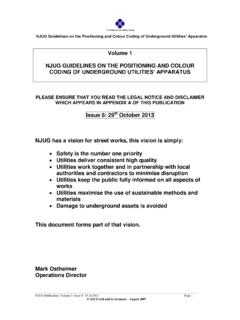Transcription of Application Note Electrochemical Gas Sensor - …
1 Application Note MEM1 Electrochemical Gas SensorMEMBRAPOR AG, Birkenweg 2, 8304 Wallisellen, SwitzerlandPhone +41 43 311 72 00 | Fax +41 43 311 72 01 | Note Electrochemical Gas of the Safety and Open Circuit Voltages for Toxic Gas and the Number and Date of Gas Sensors in Sensors Design of Potentiostatic Sensors for Low Sampling of the .. Pressure versus to Check Sensor and , H2O2, HCl, HCN, NH3, PH3, , NO2, O3, , CO, H2, of Effects of Certain Containing and and and and is producing gas sensors for OEMs of gas analyzers and detectors. It is expected that users of MEMBRAPOR products are professionals in the field of gas analysis and that they know their responsibility and their local regulations. This Application note is about Electrochemical gas sensors for toxic gases and should serve as a guidance. This documentation is not claimed to be complete and MEMBRAPOR does not accept a liability for any consequential losses, injury or damage resulting from the use of this document or the information contained within it.
2 2 Usage of the Sensor Never solder connectors directly onto Sensor pins. Connection should be made via a PCB mounting socket. To connect a Sensor with wires, use the Slim- or Standard-size which have soldering : SOLDERING TO PINS WILL RENDER YOUR WARRANTY sockets are proposed in chapter 7. If there is a short-cutting spring, remove it before plugging the Sensor in. Do not remove the white anti-condensation membrane. Sensors must not be exposed to temperatures, humidities and pressures outside the specified range in the respective data sheets. Generally: The sensors are not suitable for temperatures over 50 C and for the use in vacuum chambers. Sensors should not be exposed to organic vapor as it may influence the baseline or even cause physical damage to the Sensor body. At the end of product's life, sensors can be returned to MEMBRAPOR for professional and environment-friendly Safety ConsiderationsAn Electrochemical Sensor is a cell which produces small currents and voltages, and is not able to store large quantities of energy.
3 The current of the Sensor increases linearly over the recommended operating range of the gas concentration and is measured as the Sensor output: Sensor sensitivity [nA/ppm] x gas concentration [ppm] = output signal [ nA] and Open Circuit Voltages for Toxic Gas SensorsMaximum current in normal operation: < mAMaximum short circuit current: < AMaximum voltage in normal operation: < VMaximum open circuit voltage: < VMEM1 Appl. Note Rev. 10/2015 Page 2 of 14 MEMBRAPOR AG, Birkenweg 2, 8304 Wallisellen, SwitzerlandPhone +41 43 311 72 00 | Fax +41 43 311 72 01 | :IEC 60079 11, Simple apparatus: The following apparatus shall be considered to be simple apparatus: Sources of generated energy, which do not generate more than V, 100 mA and 25 mW. 4 Product SafetyA MEMBRAPOR gas Sensor is not considered hazardous. Should the housing be damaged, the electrolyte inside the Sensor may leak out.
4 Exposure to the Sensor electrolyte, which is diluted sulfuric acid, is the only risk that may potentially prove hazardous to health. In the event of skin contact, rinse with plenty of water and seek medical advice. The MSDS document can be downloaded at and TransportSensors should be stored in their original packaging below 30 C and between 30 % and 90 % RH. Do not store sensors together with organic solvents or flammable liquids. Electrochemical gas sensors are classed as non-dangerous and may be transported without special packaging or labeling. Nevertheless, you are advised to check any local HousingMEMBRAPOR gas sensors are available in different housings, made of polycarbonate. The housing determines the size of the electrodes. Miniature-size sensors contain smaller electrodes than the other housings and thus provide smaller signal outputs. Compact-, Slim- and Standard-size sensors have an air vent on the back, which in some applications is important.
5 Due to their large electrodes they are more resistant to poisoning of the catalyst. If the connection is made by soldering, then Slim- or Standard-size sensors are the appropriate choices as they have soldering tags for this purpose. Never solder connectors directly onto Sensor pins, this will render your warranty void. 7 Connecting the SensorA Sensor has 2 - 4 pins at the bottom for the electrical and mechanical contact. The PCB should have sockets where the Sensor with its pins can be plugged-in. In the table below suitable sockets are listed from various suppliers. Sockets with a clip give generally a safer electrical connection with the pin. They should be considered in case of vibrations or frequent plugging. The diameter of the pins is mm ( in) in the case of Compact-, Slim- and Standard-size sensors, and mm ( in) in the case of Miniature-size sensors. MEM1 Appl. Note Rev. 10/2015 Page 3 of 14 MEMBRAPOR AG, Birkenweg 2, 8304 Wallisellen, SwitzerlandPhone +41 43 311 72 00 | Fax +41 43 311 72 01 | number / FeatureSuitable , Slim, Standard9801-0-15-15-23-27-10-0 MiniatureAndon Electronics / with clipCompact, Slim, Standard9879-1-R15 / with / with clipSlim, StandardB (0 5050865 5)Compact, Slim, Standard20F2617 (2 5050871 3)MiniatureTable 1 Suitable sockets to connect sensorsThe Slim- and Standard-size sensors have additionally soldering tags, which can be used for the electrical contact.
6 8 LabelThe label on MEMBRAPOR gas sensors includes the Sensor type, the serial number and a 2D-Code which contains both information. TypeEvery Sensor type is described with a logical product code:[Gas] / [Size Sensor ] [Option Filter] [Option Variation] - [Measurement Range] - [Option 2 or 4 Electrodes] - [Option Slim if S-size]Examples:CH2O/C-10 For Formaldehyde, Compact-size, for 0-10 ppmNO/SF-2000-SFor Nitric Oxide, Slim-size, with filter, for 0-2000 ppmNH3/MR-100 For Ammonia, with fast response, for 0-100 Number and Date of ManufactureWith the individual serial number, MEMBRAPOR can trace all test results and production data, including the whole supply chain. The date of production is encoded in the first 4 digits: yyCW. yy: The year (Last 2 digits, 14 means the year 2014)CW: The calendar week in that year. the white label is a two-dimensional matrix bar code printed. It is encoded in "DataMatrix Code", ECC type: 200.
7 It includes the serial number and the Sensor type. These 2 information are separated with a Appl. Note Rev. 10/2015 Page 4 of 14 MEMBRAPOR AG, Birkenweg 2, 8304 Wallisellen, SwitzerlandPhone +41 43 311 72 00 | Fax +41 43 311 72 01 | Gas Sensors in GeneralElectrochemical sensors operate by reacting with the analyte and producing an electrical signal. Most Electrochemical gas sensors are amperometric sensors, generating a current that is linearly proportional to the gas concentration. The principle behind amperometric sensors is the measurement of the current-potential relationship in an Electrochemical cell where equilibrium is not established. The current is quantitatively related to the rate of the electrolytic process at the sensing electrode (also known as working electrode) whose potential commonly is kept constant using another electrode (the so-called reference electrode). Figure 1 Working principle of an Electrochemical gas Sensor PrincipleA MEMBRAPOR Electrochemical gas Sensor works as follows: Target gas molecules that come in contact with the Sensor first pass an anti-condensation membrane which serves also as a protection against dust.
8 Then the gas molecules diffuse through a capillary, potentially through a subsequent filter, and then through a hydrophobic membrane to reach the surface of the sensing electrode. There the molecules are immediately oxidized or reduced, consequently producing or consuming electrons, and thus generating an electric current. It is important to note that with this approach the amount of gas molecules entering the Sensor is limited by the diffusion through the capillaries. By optimizing the pathway, in accordance with the desired measurement range, an adequate electrical signal is obtained. The design of the sensing electrode is crucial in order to both achieve a high reactivity towards the target gas and to inhibit undesired responses to interfering gases. It involves a system of three phases: solid, liquid and gaseous, and all are involved in the chemical recognition of the analyte gas. MEMBRAPOR is passionately dedicated to tailor this system and obtain high-performance gas sensors.
9 The Electrochemical cell is completed by the so-called counter electrode which balances the reaction at the sensing electrode. The ionic current between the counter and sensing electrode is transported by the electrolyte inside the Sensor body, whereas the current path is provided through wires terminated with pin connectors. Commonly, a third electrode is included in an Electrochemical Sensor (3-electrode Sensor ). The so-called reference electrode serves to maintain the potential of the sensing electrode at a fixed value. For this purpose and generally for the operation of an Electrochemical Sensor a potentiostatic circuit is needed. MEM1 Appl. Note Rev. 10/2015 Page 5 of 14 MEMBRAPOR AG, Birkenweg 2, 8304 Wallisellen, SwitzerlandPhone +41 43 311 72 00 | Fax +41 43 311 72 01 | SignalThe output signal of a MEMBRAPOR gas Sensor corresponds to the concentration of a gas rather than to its partial pressure.
10 Hence, it is possible to use a MEMBRAPOR Sensor at different altitudes or even underground, independent at which atmospheric pressure the device was calibrated. A deeper and scientific explanation of the Sensor output and the pressure dependence can be found in the document MEM4. 103-Electrode Sensors Design of Potentiostatic CircuitTo operate an Electrochemical Sensor a control circuitry is required, referred to as the potentiostatic circuit. For a 3-electrode Sensor the main purpose is to maintain a voltage between the reference electrode (Ref) and the sensing electrode (Sens, also known as working electrode) to control the Electrochemical reaction and to deliver an output signal proportional to the current produced by the Sens responds to the target gas, either oxidizing or reducing the gas, creating a current flow that is proportional to the gas concentration. This current must be supplied to the Sensor through the counter electrode (Cnt).

